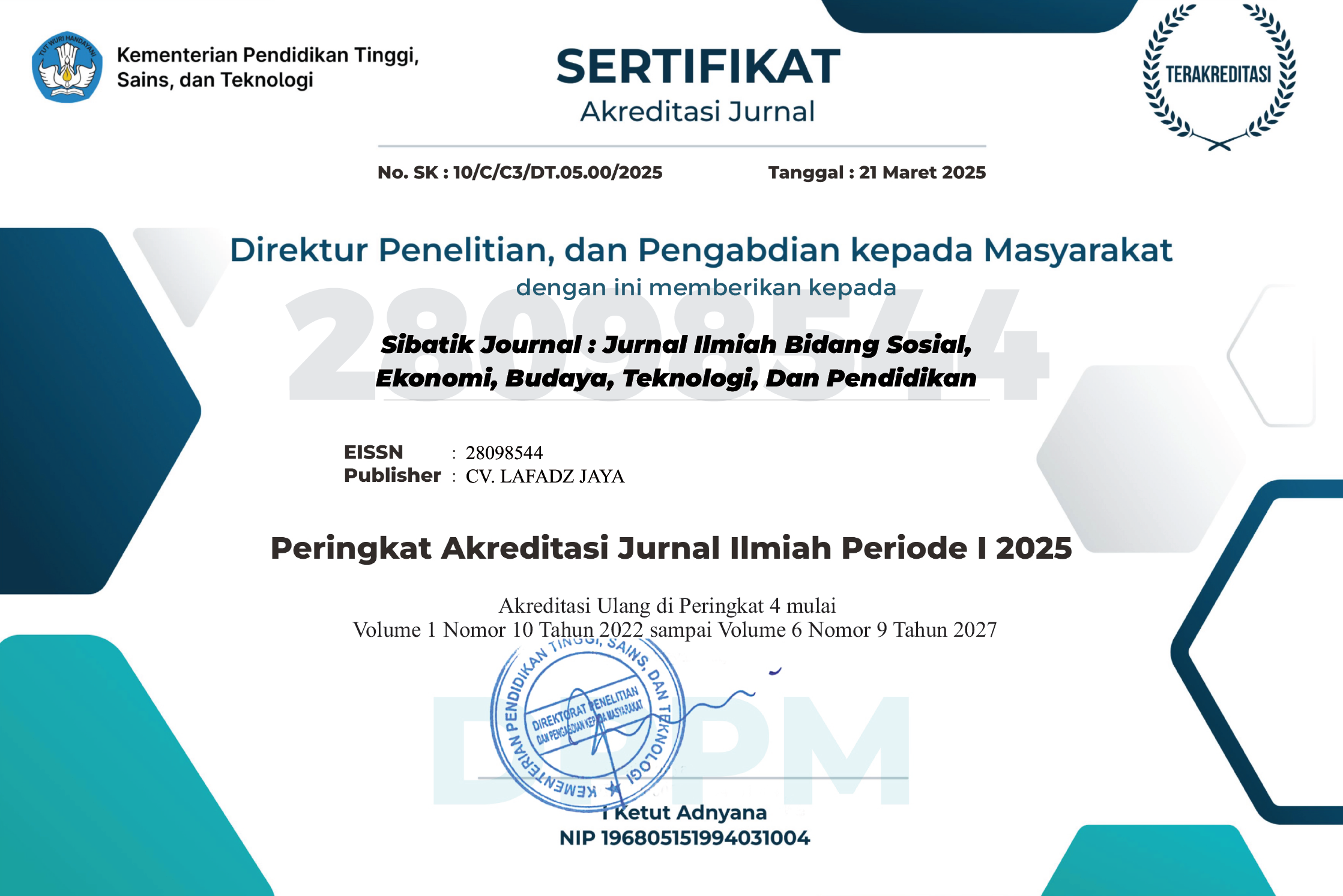PENGARUH MANAJEMEN INOVASI DAN BERBAGI PENGETAHUAN TERHADAP KEUNGGULAN KOMPETITIF PADA INDUSTRI MANUFAKTUR BATAM
DOI:
10.54443/sibatik.v4i8.3314Published:
2025-07-26Downloads
Abstract
This study investigates the impact of innovation management and knowledge sharing on competitive advantage within Batam’s manufacturing industry. In an era of rapid globalization and technological transformation, innovation and effective knowledge management are critical to achieving a competitive edge. The research employs a quantitative approach, using surveys to collect data from manufacturing firms in Batam, which is analyzed using multiple linear regression techniques. The findings demonstrate that both innovation management and knowledge sharing have a significant positive influence on competitive advantage. The study emphasizes the importance of fostering an organizational culture conducive to learning, cross-functional collaboration, and leveraging information technology to support innovation processes. This research offers practical recommendations for industry managers to develop sustainable innovation strategies and knowledge-sharing practices, ultimately boosting their firms' competitiveness.
Keywords:
Innovation Management Competitive Advantage Manufacturing IndustryReferences
Alfi Randra, & Al Hasin. (2023). Pengaruh Inovasi Produk dan Pengendalian Kualitas terhadap Keunggulan Bersaing. Jurnal Manajemen & Inovasi, 8(3), 45-58.
Argote, L., & Ingram, P. (2000). Knowledge Transfer: A Basis for Competitive Advantage in Firms. Organizational Behavior and Human Decision Processes, 82(1), 150-169.
Aulawi, H., Tjakraatmadja, J., & Lantu, D. (2009). The Role of Knowledge Sharing in Organizational Innovation. Journal of Knowledge Management, 13(4), 78-92. https://doi.org/10.1108/13673270910993488
Barney, J. B. (1991). Firm Resources and Sustained Competitive Advantage. Journal of Management, 17(1), 99-120.
Becerra, M., & Sabherwal, R. (2010). Knowledge Management: Systems and Processes. Journal of Knowledge Management, 14(2), 123-135. https://doi.org/10.1108/13673271011023189
Becker, M., & Schenk, E. (2020). Knowledge Sharing and Innovation: A Comprehensive Overview of the Literature. Journal of Innovation Management, 25(3), 95-112.
Bontis, N. (2001). Managing Organizational Knowledge by Diagnosing Intellectual Capital: Framing and Advancing the State of the Art. International Journal of Technology Management, 22(5-6), 44-57.
Calati, E., & Faggiolani, L. (2023). Energy Storage and Thermal Management in Freezers: The Role of Phase Change Materials. Energy Efficiency Journal, 12(2), 41-58. https://doi.org/10.1109/EEJ.2023.1287493
Davenport, T. H., & Prusak, L. (1998). Working Knowledge: How Organizations Manage What They Know. Harvard Business Press.
Desouza, K. C., & Evaristo, R. (2004). Global Knowledge Management: Exploring the Role of Technological Infrastructure. Journal of Global Information Technology Management, 7(4), 28-39.
Drucker, P. F. (1985). Innovation and Entrepreneurship: Practice and Principles. Harper & Row.
Dwi Rama Jaya, R. ., Taufiq Ibrahim, M. ., Riansyah, R., & Nur Happy, W. . (2021). Analisis Pengaruh Jumlah Industri, Jumlah Penduduk Dan Nilai Investasi Sektor Industri Kecil Dan Industri Non-Formal Manufaktur Di Kota Palembang. Sibatik Journal: Jurnal Ilmiah Bidang Sosial, Ekonomi, Budaya, Teknologi, Dan Pendidikan, 1(1), 45–52. https://doi.org/10.54443/sibatik.v1i1.5
Ginting, S., Munthe, T., & Ibrahim, R. (2023). Knowledge Management terhadap Inovasi dan Daya Saing Berkelanjutan. Jurnal Manajemen Bisnis, 14(2), 88-101. https://doi.org/10.1016/j.jmb.2023.04.003
Gnyawali, D. R., & Park, B. (2011). Co-opetition and Technological Innovation in Small and Medium-Sized Enterprises: A Multilevel Perspective. Journal of Business Venturing, 26(4), 440-453. https://doi.org/10.1016/j.jbusvent.2010.05.002
Grant, R. M. (1996). Toward a Knowledge-Based Theory of the Firm. Strategic Management Journal, 17(S2), 109-122.
Gupta, A. K., & Govindarajan, V. (2000). Knowledge Management’s Role in Innovation. Academy of Management Perspectives, 14(4), 67-77.
Haldin-Herrgard, T. (2000). Difficulties in Diffusing New Ideas: The Case of Knowledge Management. Journal of Knowledge Management, 4(3), 204-213.
Liao, S. H., & Chang, W. (2017). Knowledge Sharing and Organizational Innovation: The Moderating Effect of Organizational Culture. International Journal of Information Management, 37(5), 419-428. https://doi.org/10.1016/j.ijinfomgt.2017.02.004
Liswatin, L. (2022). Inovasi Pengelolaan Pajak Dan Retribusi Daerah Dalam Peningkatan Pendapatan Asli Daerah Di Kabupaten Konawe. Sibatik Journal: Jurnal Ilmiah Bidang Sosial, Ekonomi, Budaya, Teknologi, Dan Pendidikan, 1(3), 83–96. https://doi.org/10.54443/sibatik.v1i3.15
Nonaka, I., & Takeuchi, H. (1995). The Knowledge-Creating Company: How Japanese Companies Create the Dynamics of Innovation. Oxford University Press.
Porter, M. E. (1985). Competitive Advantage: Creating and Sustaining Superior Performance. Free Press.
Senge, P. M. (1990). The Fifth Discipline: The Art and Practice of the Learning Organization. Doubleday.
Tidd, J., & Bessant, J. (2020). Managing Innovation: Integrating Technological, Market and Organizational Change. John Wiley & Sons.
Tjakraatmadja, J., & Lantu, D. (2006). Knowledge Management: The Key to Building Competitive Advantage in Knowledge-Based Economy. Business Strategy Review, 7(1), 21-29.
Vance, C. M., & Rainer, S. (2016). The Role of Knowledge Sharing in Innovation and Organizational Change. Academy of Management Perspectives, 30(3), 65-82. https://doi.org/10.5465/amp.2016.0138
Wahib, H., & Susanto, D. (2024). Penerapan Strategi Manajemen Inovasi dalam Meningkatkan Daya Saing Perusahaan. Jurnal Ekonomi dan Manajemen, 19(4), 65-79.
Wibowo, A. (2024). Manajemen Inovasi dan Keunggulan Bersaing dalam Perusahaan Industri. Jurnal Ilmu Manajemen, 11(1), 105-120. https://doi.org/10.1177/245425072410122
License
Copyright (c) 2025 Tomi Alfa, Amirul Mustofa, Eddy Yunus

This work is licensed under a Creative Commons Attribution 4.0 International License.












